| کد مقاله | کد نشریه | سال انتشار | مقاله انگلیسی | نسخه تمام متن |
|---|---|---|---|---|
| 10974853 | 1108029 | 2015 | 14 صفحه PDF | دانلود رایگان |
عنوان انگلیسی مقاله ISI
Low-sodium Cheddar cheese: Effect of fortification of cheese milk with ultrafiltration retentate and high-hydrostatic pressure treatment of cheese
ترجمه فارسی عنوان
پنیر کم سدیم چدور: تأثیر غنیسازی پنیر با استفاده از رطوبت اولترافیلتراسیون و فشار بالای هیدرواستاتیک پنیر
دانلود مقاله + سفارش ترجمه
دانلود مقاله ISI انگلیسی
رایگان برای ایرانیان
کلمات کلیدی
پردازش فشار بالا، تنظیم مجدد شیر، پنیر سدیم کم،
موضوعات مرتبط
علوم زیستی و بیوفناوری
علوم کشاورزی و بیولوژیک
علوم دامی و جانورشناسی
چکیده انگلیسی
Low-sodium cheeses often exhibit an acidic flavor due to excessive acid production during the manufacturing and the initial stage of ripening, which is caused by ongoing starter culture activity facilitated by the low salt-in-moisture levels. We proposed that this excessive starter-induced acidity could be prevented by the fortification of cheese milk with ultrafiltration (UF) retentates (to increase curd buffering), and by decreasing microbial activity using the application of high-hydrostatic pressure (HHP) treatment (that is, to reduce residual starter numbers). Camel chymosin was also used as a coagulant to help reduce bitterness development (a common defect in low-sodium cheeses). Three types of low-Na (0.8% NaCl) Cheddar cheeses were manufactured: non-UF fortified, no HHP applied (L-Na); UF-fortified (cheese milk total solids = 17.2 ± 0.6%), no HHP applied (L-Na-UF); and UF-fortified, HHP-treated (L-Na-UF-HHP; 500 MPa for 3 min applied at 1 d post-cheese manufacture). Regular salt (2% NaCl) non-UF fortified, non-HHP treated (R-Na) cheese was also manufactured for comparison purposes. Analysis was performed at 4 d, 2 wk, and 1, 3, and 6 mo after cheese manufacture. Cheese functionality during ripening was assessed using texture profile analysis and dynamic low-amplitude oscillatory rheology. Sensory Spectrum and quantitative descriptive analysis was conducted with 9 trained panelists to evaluate texture and flavor attributes using a 15-point scale. At 4 d and 2 wk of ripening, L-Na-UF-HHP cheese had ~2 and ~4.5 log lower starter culture numbers, respectively, than all other cheeses. Retentate fortification of cheese milk and HHP treatment resulted in low-Na cheeses having similar insoluble calcium concentrations and pH values compared with R-Na cheese during ripening. The L-Na-UF cheese exhibited significantly higher hardness values (measured by texture profile analysis) compared with L-Na cheese until 1 mo of ripening; however, after 1 mo, all low-Na cheeses exhibited similar hardness values, which were significantly lower than R-Na cheese. Pressure treatment significantly increased maximum loss tangent (meltability) from rheology testing and decreased melt temperature. Sensory results indicated only very slight bitterness (<2.5 out of 15-point scale) was detected in all cheeses during the 6 mo of ripening. The L-Na-UF-HHP cheese did not significantly differ in bitterness and acidity from R-Na cheese during ripening. Pressures treatment of cheese at 500 MPa and cheese milk retentate fortification could be used to improve the quality of low-Na cheese.
ناشر
Database: Elsevier - ScienceDirect (ساینس دایرکت)
Journal: Journal of Dairy Science - Volume 98, Issue 10, October 2015, Pages 6713-6726
Journal: Journal of Dairy Science - Volume 98, Issue 10, October 2015, Pages 6713-6726
نویسندگان
M. Ozturk, S. Govindasamy-Lucey, J.J. Jaeggi, M.E. Johnson, J.A. Lucey,
